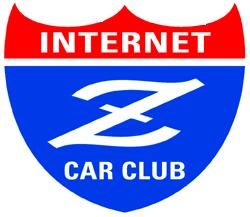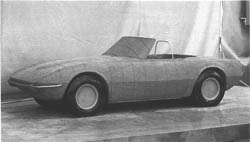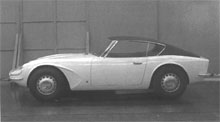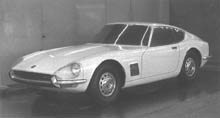"The Design Evolution Of The Datsun 240-Z"


Contributed by: Carl J. Beck
as of: 12 May 04
Mr. Yutaka Katayama, the man recognized as "the Father Of The Z Car"; was inducted into the "Automobile Hall Of Fame" in 1998, in large part due to his championing of the Z Car for his American Customers, and his shepherding of the product from concept to delivery.
Now close to 35 years after its public introduction, interest in the Z Car and its history is reaching new levels. People want to know how this world class Sports/GT came about when the general Sports/GT market in the US was loosing market share to the onslaught of the 60's era Muscle Cars and Pony Cars.
Today Classic Car Collectors, Sports Car Enthusiasts and Automotive History Buffs want to know how such a milestone car came about in the first place. They want to know who was responsible for its design and how it made it out of the styling studio's and through the production process without being drastically altered along the way.
Because people want to know the true story of the Z Car - I hope that which follows will shed new light on the subject.
Carl
SETTING THE RECORD STRAIGHT:
Contrary to reports in the Automotive Press at the time of its introduction, and as repeated in various books written on the subject of the "Z Car" in the years that followed; the design and development of the DATSUN 240-Z was entirely the work of Nissan Motors Ltd. employees. Lets look at how it really happened according to the men that made it happen. Mr. Yutaka Katayama, President Of Nissan Motors North America and Mr. Yoshihiko Matsuo, Chief of Design for Sports Car Design "Project Z".
LETS START AT THE END:
Just for fun, lets start our journey at the end of the design and initial production phases.
At the 1969 introduction of the new DATSUN 240-Z to the employees of Nissan Motors USA, Mr. Yutaka Katayama, President, Nissan Motors USA said:
"The 240-Z represents the imaginative sprit of Nissan, and was designed to please a demanding taste that is strictly American. It meets all the requirements of sports-minded drivers, fulfilling their desire for superb styling, power and safety, and provides them with the most thrilling and enjoyable ride available in any car."
Mr. Katayama continued; "Our new product reflects the rapid advancement of our company... We have studied the memorable artistry of European coachmakers and engine builders and combined our knowledge with the Japanese craftsman. The result is an exotic, high-performance car exclusively for America."
1965 - A FAILURE THAT LEAD TO LATER SUCCESS:
 After showing their latest design effort at the 1965 New York Auto Show. Nissan Motors USA removed the Goertz designed "Nissan Silvia 1600 Sports Coupe" from the show car circuit early, and sent it directly back to Japan. (it was not shown in LA, Chicago, Washington DC, Atlanta etc. as is normally the case on the International Show Car circuit here in the US).
After showing their latest design effort at the 1965 New York Auto Show. Nissan Motors USA removed the Goertz designed "Nissan Silvia 1600 Sports Coupe" from the show car circuit early, and sent it directly back to Japan. (it was not shown in LA, Chicago, Washington DC, Atlanta etc. as is normally the case on the International Show Car circuit here in the US).
The feedback from the DATSUN Dealers was quite negative on the car, as was the Automotive Press's comments here in the US. Nonetheless the "Silvia 1600 Sports Coupe" did generate interest in, and discussion about DATSUN's next generation offering in the Sports Coupe and Sports Car field in America.
One of the most noted and most influential Dealers was no less than Bob Sharp. When it came to "Sports Cars" Mr. Sharp's Championship efforts racing DATSUNS carried a lot creditability with NISSAN's USA H.Q.. Mr. Sharp reports that he told Nissan that the Silvia Sports Coupe was entirely too small and cramped; as well, being underpowered it was too slow for the American highways. (ed..Mr. Sharp is 6'2" tall)
The DATSUN Dealers told Nissan that to be competitive in the Sports/GT market, they needed a car that was better suited to American size people with far more powerful engines. Of course it had to be both beautiful and competitively priced.
Over the two years that followed the 65 New York Auto Show, Mr. Yutaka Katayama, President of Nissan Motors USA, gathered the inputs from his DATSUN Dealers around the Country, and from Nissan Motors USA Marketing Department studies. With customer requirements broadly defined, he headed to Japan. Mr. K hoped to provide the home offices with solid customer based product requirements, as outlined by his American customers - the DATSUN Dealers.
By 1966 Mr. Katayama had been successful in getting many of his American design requirements incorporated into the design of the up-coming PL510. Of most note was his political battles with the Home Offices in Japan during this period. Mr. K fought for and got a larger, more powerful 1600cc Overhead Cam Engine in the PL510. (Mr. K actually went over the heads of Nissan Motors Ltd. top management, and enlisted political support from old friends at MIDI - this corporate battle is legendary !!)
Engineers from Prince Motors had designed a new head with an Overhead Cam Design that was fitted to a previous Nissan Overhead Valve 4 cylinder engine. The retsult was the Nissan U20 2.0 liter OHC engine used in the Datsun 2000 roadster. Nissans Small Engine Design Department then designed the new L16, a 1600cc OHC 4 cylinder engine. Mr. Katayama needed it to be put into production for the American Market, installed in the upcomming PL510. Mr. Katayama got the engine he wanted and Nissan Motors Ltd. got the export sales they needed. The DATSUN 510 was a huge sales success in America and is to this day supported by a very large enthusiasts group.
WITHIN NISSAN MOTORS Ltd. JAPAN
By 1965 the responsibility for the Design and Development of Nissan Motors Ltd.'s automotive products rested within its own Engineering Design and Development Department, headed by Mr. Teiichi Hara. Mr. Hara had total responsibility for the Design and Development of both Passenger Vehicles and Trucks/Vans. Mr. Kazumi Yotsurnoto reported to Hara and was the head of the Passenger Car Styling Studio's.
"Design Project Z" so named was assigned by Mr. Hara to: Development Section 1 (Passenger Cars), Styling Studio No. 4 (Sports Car Styling). Styling Studio No. 4 was headed by Mr. Yoshihiko Matsuo, Chief Designer.
 From the beginning of 1965 to late 1966 Mr. Matsuo and his team worked on several alternative concepts for Nissan's next generation Sports Car. During this period Mr. Matsuo reports that his main concept was of a modern, light weight roadster with a 2.0L four cylinder engine. Slightly larger than the existing Fairlady.
From the beginning of 1965 to late 1966 Mr. Matsuo and his team worked on several alternative concepts for Nissan's next generation Sports Car. During this period Mr. Matsuo reports that his main concept was of a modern, light weight roadster with a 2.0L four cylinder engine. Slightly larger than the existing Fairlady.
 Mr. Matsuo tells us that he believed he and his team could design a world class sports car, but that Nissan at the time was far to conservative to make such radical changes in their products. So as he kept his favorite concept alive, he also offered alternative and more conservative designs to the management chain, such as a Silvia based roadster.
Mr. Matsuo tells us that he believed he and his team could design a world class sports car, but that Nissan at the time was far to conservative to make such radical changes in their products. So as he kept his favorite concept alive, he also offered alternative and more conservative designs to the management chain, such as a Silvia based roadster.
KEEPING THE DREAM ALIVE:
As time passed between early 1965 and late 1966 Mr. Matsuo was feeling the pressure from his management chain to remain on the conservative path and simply renew or upgrade existing products such as the Fairlady Roadster or the previously designed Silvia Sports Coupe. However a visit from Mr. Katayama buoyed Mr. Matsuo's courage and keep his dream of a world class sports car alive.
Mr. Matsuo states that Mr. Katayama, while visiting Matsuo's Styling Studio said to him; "..we could go on making cheap economy cars forever, but by doing so, we would never be able to move forward in export markets. Nissan, and Japan as a whole, needed to build something stunning, something original that would make the foreign manufacturers sit up and take notice of us."
 By the end of 1966, Mr. Matsuo had evolved his original concept from a roadster to a hatchback coupe. US Motor Vehicle Safety Standards made the future of convertibles questionable at best, and Mr. Katayama had said that a closed coupe would be the best compromise for the US market. It was also during this time that the Z trade mark "Sugar Scoop" headlight treatment was chosen, as a way to meet the US SAE headlight height standards for the US market, without the use of Corvette style flip up headlights.
By the end of 1966, Mr. Matsuo had evolved his original concept from a roadster to a hatchback coupe. US Motor Vehicle Safety Standards made the future of convertibles questionable at best, and Mr. Katayama had said that a closed coupe would be the best compromise for the US market. It was also during this time that the Z trade mark "Sugar Scoop" headlight treatment was chosen, as a way to meet the US SAE headlight height standards for the US market, without the use of Corvette style flip up headlights.
 Mr. Katayama had been lobbying H.Q. for newer and fresher products aimed more squarely at his American market, and Mr. Matsuo said he needed to enlist Mr. Katayama's support for the more revolutionary "Matsuo" sports car concepts (which were then being discouraged by his manager). With Mr. Katayama's support for Mr. Matsuo's concepts, in 1967 the next generation sports car design effort started to progress in earnest and Engineering was brought into the design team.
Mr. Katayama had been lobbying H.Q. for newer and fresher products aimed more squarely at his American market, and Mr. Matsuo said he needed to enlist Mr. Katayama's support for the more revolutionary "Matsuo" sports car concepts (which were then being discouraged by his manager). With Mr. Katayama's support for Mr. Matsuo's concepts, in 1967 the next generation sports car design effort started to progress in earnest and Engineering was brought into the design team.
At that point, Mr. Matsuo had planned to use the U20 2.0 Liter 4 cylinder engine from the Fairlady 2000 roadster. Mr. Katayama however wanted the 2.4 Liter, L-24 series engine from the newly merged Prince Motors. Mr. Matsuo reports that the transmission tunnel had to be widened to accommodate the A/T behind the L-24. So the entire car had to be made wider to still maintain cabin room for American size driver and passenger. Additionally, the hood height had to be increased to install the larger 6 cylinder engine. Thus, the concept prototype became longer, higher and wider, but sill Mr. Matsuo and his team were able to maintain the over-all styling and proportions of the design.
Mr. Matsuo notes that because the Japanese domestic market placed heavy taxes on any engine displacement over 2.0 liters, Nissan Management directed him to use the 2.0 liter in-line six also developed by Prince Motors, the S20 twin cam. (which became the now famous Z432 - incidentally!!).
SO WHO DID DESIGN THE DATSUN 240-Z?
Working within the product specifications, design requirements and design constraints defined and provided by their target market; the concept development, styling and design work was done by the following people. Mr. Katayama and Mr. Matsuo in their writing on the subject over the years, as well as their writings in the book they co-authored; "FAIRLADY Z STORY" finally revel the identity of the real Z Car Design Team. (something not often done in Japanese corporations today - and certainly not done in the late 60's or early 70's)
Mr. Teiichi Hara, Manager Nissan Design and Development
Mr. Kazumi Yotsurnoto, Manager, Passenger Car Styling Section
Mr. Yoshihiko Matsuo, Chief of Design, Styling Studio #4
Mr. Akio Yoshida, Assistant Designer (Exterior Design)
Mr. Sue Chiba (Interior Design)
Mr. Eiichi Oiwa and Mr. Kiichi Nishikawa (Styling Studio Assistants)
Mr. Hidemi Kamahara and Mr. Tsuneo Benitani, Design Engineers
(engineering everything under the skin).
WHY SUCH INTEREST SOME 35 YEARS LATER?
The design of the DATSUN 240-Z established a complete paradigm shift in the automotive industry. For the first time a major manufacturer designed and produced a product line aimed specifically and squarely at a target export market. Using customer requirements from that market to both define and constrain the development effort.
Working with broadly defined customer requirements and very narrowly defined design constraints; Mr. Matsuo and his team were both creative and flexible enough to be able to incorporate all the product and design requirements coming from Mr. Katayama and his American customers, as well as all the US Federal Safety and Emissions Standards. This was all accomplished without sacrificing the design nor the styling integrity of the car. An equally significant feat was accomplished by Mr. Matsuo as he got his design through the design to production transition phase, without sacrificing its design integrity. (this is very rarely accomplished).
In Closing I'll Quote Mr. Matsuo:
"...with the birth of the Z the complexion of the American Sports Car Market changed overnight."
(A typical Matsuo understatement...cjb)
Carl
SPORT Z MAGAZINE, Volume 4, Issue I
Interview with Mr. Matsuo by Brian Long
Robert Bell, Publisher, USA
Nissan/Datsun, a history of Nissan Motor Corporation in USA 1960-1980
by: John Bell Ray
Published: 1982 ISBN 0-07-051112-8
THE RECKONING
by: David Halberstam
Published: 1986 - ISBN 0-688-04838-2
DATSUN Z FAIRLADY TO 280Z - By: Brian Long
Published: 1998 - ISBN 1 901295 02 8